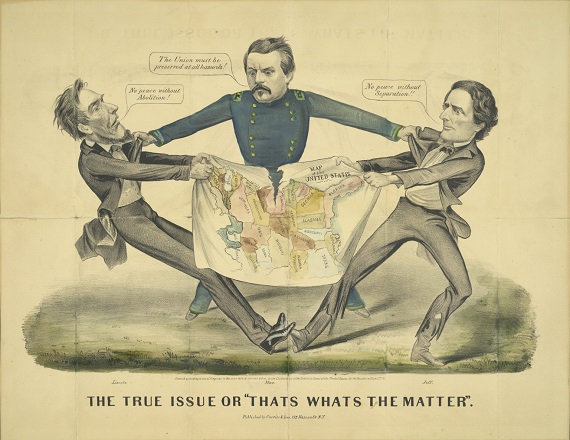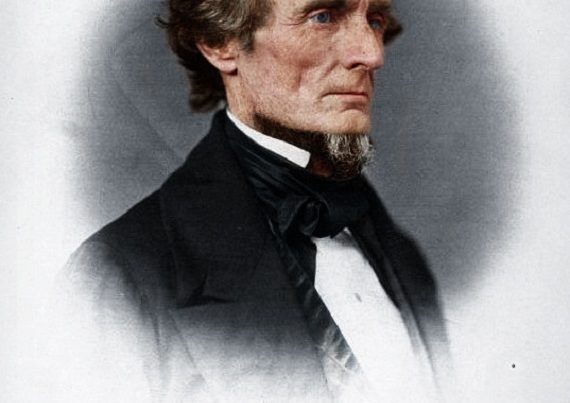Fifty years ago the master narrative of the Civil War Centennial failed to synchronize with the momentous 1960s Civil Rights movement. It minimized the roles of slavery and race. Instead the War was characterized as a unifying ordeal in which both sides fought heroically for their individual sense of “right” eventually becoming reconciled through mutual sacrifice. Slavery was considered only one of several causes of the War.
Afterwards most historians began rejecting the Centennial interpretation. Yale professor David Blight explains that historians who came-of-age during the 1920s economic boom, ensuing crash, and Great Depression were the ones chiefly responsible for shaping the twentieth century understanding of the War’s causes – until the 1960s. Such writers “tended to see the world through the frame of the Great Depression” and interpreted sectional differences as more important than differing ideologies on slavery.
His signature example was Charles Beard who “saw the South and North as essentially two economies. . . . [U]ltimately the Civil War, in Beard’s view, wasn’t really about any particular ideology . . . it was two economic systems living together in . . . the same nation, and coming into conflict with one another in insolvable ways; forces meeting at a crossroads and they had to clash. Beard is laden with inevitability, as any great economic determinist usually is.”
If Blight correctly reasons the accepted causes of the Civil War fifty years ago were distorted because the Great Depression personally affected influential authors, it is reasonable to examine whether the Civil Rights movement similarly impacted Sesquicentennial historians. Princeton’s James McPherson is a good starting place. He won a 1989 Pulitzer Prize for Battle Cry of Freedom, which was his historical interpretation of disunion and the War. His influence is evident from the book’s massive popularity as a college text. Moreover, he’s repeatedly stated that the 1960s Civil Rights movement molded his study of the War. The affect was evident as early as his dissertation selection:
…[T]he selection of a dissertation topic was one of the most difficult experiences during my four years at Johns Hopkins from 1958–1962. . . . My adviser…encouraged me to write . . . on Alabama Reconstruction. . . [T]he Civil Rights Movement was in full swing, and I knew [presumed?] that as a Yankee (born in North Dakota and raised in Minnesota) I might be less than welcome in Alabama. The prospect…left me considerably less than ecstatic. . . Meanwhile, I had become fascinated with the abolitionists… My empathy with these civil rights activists generated more excitement than…Alabama.
Additionally, McPherson echoes Blight’s criticism of Beard: “As Beard viewed it, slavery and emancipation were almost incidental to the real causes and consequences of the war. The sectional conflict arose from the contending economic interests.” On the eve of the Sesquicentennial McPherson concluded that Beard’s once popular economic-centric explanation had been nearly universally rejected by contemporary historians, who define slavery as the overarching cause: “Probably 90 percent, maybe 95 percent, of serious historians of the Civil War would agree on…what the war was about . . . which was the increasing polarization of the country between the free states and the slave states over issues of slavery, especially the expansion of slavery.”
After winning the Pulitzer, McPherson steadily attracted followers. While nearly all correctly emphasizes slavery as the reason the cotton states seceded, they generally fail to satisfactorily explain why the North declined to let the South depart peacefully. After all, if the South quietly left the Union, slavery would have ceased to exist in the United States. It was precisely what prominent abolitionists frequently advocated prior to the War. Examples include William Lloyd Garrison, Henry Beecher, Samuel Howe, John Greenleaf Whittier, James Clark, Gerrit Smith, Joshua Giddings, and even Massachusetts Senator Charles Sumner who became a leading war hawk. For years Garrison described the United States Constitution as “a covenant with death and agreement with hell.”
Moreover, Lincoln continually rejected emancipation for the first seventeen months of the War. During the first year, he overruled Major Generals David Hunter and John C. Fremont when each attempted to emancipate slaves in their districts. As late as August 1862, he famously replied in a letter to publisher Horace Greely’s call to free the slaves, “My paramount objective in this struggle is to save the Union, and not either to save or destroy slavery. If I could save the Union without freeing any slave, I would do it and if I could do it by freeing all the slaves, I would do it; if I could do it by freeing some and leaving others alone, I would also do that.” In short, “saving the Union” was really a slogan to avoid the consequence of disunion. The reasons are chiefly linked to economics, not abolitionism.
A surviving independent Confederacy would undoubtedly employ much lower tariffs than the United States. In his inaugural address President Jefferson Davis stated, “Our policy is peace, and the freest trade our necessities will permit. It is . . . [in] our interest, and that of [our trading partners], that there should be the fewest practicable restrictions upon interchange of commodities.” Similarly Confederate Secretary of State Judah Benjamin later offered France a special tariff exemption “for a certain defined period” in exchange for diplomatic recognition.
A low Confederate tariff presented the remaining states of the Union with two consequences. First, the federal government would lose the great majority of its tax revenue because 82% were obtained from tariffs. Articles imported into the Confederacy from Europe would divert tariff revenue from the North to the South. Additionally, the Confederacy’s low duties would encourage Northern-bound European imports to enter in the South, where they could be smuggled across the Ohio River into Midwestern states and thereby evade US duties. Tariff compliance would nearly vanish and cause a collapse in federal tax revenue. Second, given the Confederacy’s lower tariffs its residents would likely buy more manufactured goods from Europe rather than as previously from the Northern states where prices were inflated by protective tariffs.
It was quickly realized that such concerns were not mere abstractions. In March 1861 New Yorkers were panicked to read a dispatch from St. Louis in a Manhattan newspaper: “Every day…our importers are receiving, by way of New Orleans very considerable quantities of goods, duty free…If this thing is to become permanent, there will be an entire revolution in the course of trade and New York will suffer terribly.” Cincinnati also reported that goods were arriving from New Orleans tariff-free. Three months earlier the Philadelphia Press editorialized, “It is the enforcement of the revenue laws, not the coercion of the [Rebel] state[s] that is the question of the hour. If those laws cannot be enforced, the Union is clearly gone.” Historian Charles Adams explains:
If trade were to shift to the Southern ports because of a free trade zone, or extremely low duties relative to the North, then [the] great cities [of the Northeast] would go into decline and suffer economic disaster. The image painted by these editorials [from secession-era newspapers of Northeastern cities] is one of massive unemployment, the closing of factories and businesses, followed by unrest, riots, and possibly revolution. The inland cities of the North would also go into decline, like Pittsburg, where duty-free British steel and iron products would cripple the American steel industry.
States northwest of the Ohio River had additional economic reasons to fear dissolution of the Union. Specifically, they were apprehensive that the Confederacy would jeopardize free trade to the mouth of the Mississippi River. The concern was sufficiently acute that some Midwesterners toyed with the notion of forming a Northwest Confederacy of states to be allied with the Southern Confederacy. Although the Davis government promised that the river would be open to free trade, many Midwesterners regarded such assurances as mere paper guarantees. They remained worried that the Confederacy may impose fees and import duties at some future date.
Finally, after the opening guns at Fort Sumter many Northern capitalists reasoned that a war would be good for business. Initially, Wall Street looked at disunion as a menace to their investments. Government bond quotations dipped with every incident of federal indecision. But eventually Northern industrialists correctly reasoned that the demand for war goods would lift the overall economy. Since hostilities would block much of the Mississippi River trade, eastern merchants concluded that they could monopolize commerce with the Midwest. Manufacturers would get many profitable military supply contracts. The Midwestern states would supply Union armies with provender. Such expectations proved to be valid. From 1860 to 1865, the gross national product increased from $4.3 billion to $9.9 billion, which translates to an 18 percent compounded annual growth rate. Since the economy in the South was shrinking, the rate applicable to the Northern states was probably well above 20 percent annually.
Critics of the Centennial storyline have successfully placed slavery and race at the center of the Sesquicentennial narrative. Some have over-corrected to a point where some historians are wrongly blacklisted as “neo-confederates.” One example is Gary Gallagher of the University of Virginia. Despite agreeing that slavery was “central to the coming of the War and the conflict itself” his most important books focus on Confederate topics thereby leaving him feeling compelled to explain, “Don’t dismiss me as a ‘neo-Confederate’…As a native of Los Angeles who grew up on a farm in southern Colorado, I can claim complete freedom from any. . .special pleading…[and] not a single ancestor fought in the war.”
Consequently, during the past fifty years numerous authors apparently competed with one another to devalue everything about the Confederacy to the point of absurdity. E. L. Doctorow’s fictional account of Sherman’s March to the Sea entitled The March became a best seller, won the National Book Critic’s Circle Award, and was made required reading at a Yale University Civil War history course, while portraying every male Southerner in the story as a reprehensible person. Characteristic of the dogma that typically depicts Southern failures as resulting from stupidity or arrogance, modern Antietam scholars conclude that Lee’s invasion of the North after Second Bull Run was driven by overconfidence. Yet they fail to even consider an important aspect of his viewpoint, which was the fact that Beauregard and Johnston were castigated in Richmond about a year earlier for failing to try what Lee attempted. Annapolis students are taught the consensus of historians agree that Grant was the War’s best general. Bruce Levine portrays as undisputed fact a dubious allegation denied by Lee that he whipped a female slave. The list goes on and on.
Those who worry that the “Gone With the Wind” version of Civil War history currently holds much public influence fear a ghost. By capturing an average 66% share of the TV audience over eight nights the race-centered narrative of the “Roots” miniseries has surely been as influential as the countervailing account provided by Scarlett’s story. It has been 37 years since “Roots” shifted Hollywood’s Civil War focus to slavery and race. By comparison, the interval between “Gone With the Wind” and “Roots” was 38 years. Historians should lead public knowledge about the war, not trail it by 37 years. It’s time to give up the ghost.







